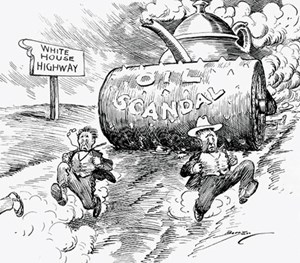Energy issues
Since I am an old git, I reserve the right to wander the hallways of history. At least once a day, something comes along to shift my mind toward the past. That something, at the end of January, was the announcement of the closing of Naval Petroleum Reserve Number 3 (NPR-3). Its demise ends 100 years of U.S. history, that included the most serious scandal prior to Watergate in the 1970s.

NPR-3, consisting of 9,481 acres, 35 miles north of Casper, Wyoming, was created in 1915. Its creation reflected the evolution in naval warfare from coal-burning warships to oil-fueled ships, at the beginning of the First World War. Coal was a less-efficient, less-reliable fuel and, more importantly, difficult to transport and load onto ships. At the end of the coal-burning era, the U.S. had coaling stations to replenish warship fuel bunkers, located strategically around the world. Defending and maintaining these stations, often in remote, potentially hostile places, was a major security and logistical nightmare, as was fueling the ships manually with coal shovels. But, switching to oil for fuel was not without its own set of problems. Chief among them was supply. What would happen to America’s defenses if its oil ran out?
Creation of Teapot Dome. In response to fears of limited oil supplies, the Navy asked Congress to set aside federal lands in places where oil was known, or thought, to exist. These naval petroleum reserves were not to be drilled, unless a national emergency made it necessary. Three sites were set aside, one near Salt Creek in northern Natrona County, Wyoming. Close by, a rock formation resembled a teapot, complete with a spout (it fell off long ago). That gave the site its name—the Teapot Dome.
Fast-forward five years, and we find President Warren G. Harding in the White House (although not for long, as he died mid-term in 1923). Harding appointed rancher and New Mexico Senator Albert Fall to be his Secretary of the Interior. Fall shortly convinced Harding to shift control of the Naval Petroleum Reserves from the Navy to the Department of Interior, arguing that DOI was better-able to protect these areas. He then enlisted friends Edward Doheny and Harry Sinclair, in secret deals, to develop Teapot Dome, in exchange for some $385,000 (roughly $5.4 million in 2014 dollars) in bribes.
The scandal. According to the Wyoming Historical Society, future Wyoming Governor Leslie Miller smelled foul play, when he saw Sinclair trucks hauling drilling equipment into the Teapot Dome reserve. Miller took the issue to a friend in the U.S. Senate, and an investigating committee was commissioned. The committee’s findings were bleak. Secretary Fall was tried and convicted for accepting bribes, and sent to federal prison. Sinclair was sentenced to nine months in prison for Contempt of Congress. Ironically, Harding croaked on a trip out West during the investigation, thereby escaping impeachment and possible imprisonment. The leases, after contentious litigation, were cancelled by the U.S. Supreme Court, and normalcy returned to Teapot Dome.
Later history. Aside from some exploratory and offset wells drilled in the 1950s and 1960s, the Teapot Dome oil field was, essentially, closed until full development resumed in 1976. In 1977, jurisdiction for the reserve was transferred from the Navy to the Department of Energy (DOE). In 1993, it became the home of the Rocky Mountain Oilfield Testing Center (RMOTC), managed by DOE as a commercial testing facility. Under 40 years of DOE management, the field produced over 22 MMbbl of oil, contributing $569 million to the U.S. Treasury.
However, the Teapot Dome experiment is now officially closed. In 2013, DOE recommended to Congress that NPR-3 (with remaining reserves of some 300 MMbbl) be sold to the private sector for continued use as an oil field. After competitive bidding, DOE sold the field, including all mineral rights and about 9,000 acres of land, to Stranded Oil Resources Corporation, a unit of Allegheny Corporation, for $45 million. The remaining surface acreage is scheduled to be transferred in May. Stranded Oil will pursue development of the field, which produces about 200 bopd from stripper wells.
It’s been more than 90 years since the Teapot Dome scandal, but its memory lingers. According to politico.com, during a congressional hearing on the scandal in 1924, Fall said of the events, “Sir, if you have a milkshake, and I have a milkshake, and my straw reaches across the room, I’ll end up drinking your milkshake.” A version of that line was used in the 2007 film, “There Will Be Blood,” a dark drama about a ruthless independent oilman. That’s probably not the last time that Teapot Dome will be referenced. ![]()

- What's new in production (February 2024)
- Prices and governmental policies combine to stymie Canadian upstream growth (February 2024)
- U.S. operators reduce activity as crude prices plunge (February 2024)
- U.S. producing gas wells increase despite low prices (February 2024)
- U.S. drilling: More of the same expected (February 2024)
- U.S. oil and natural gas production hits record highs (February 2024)


